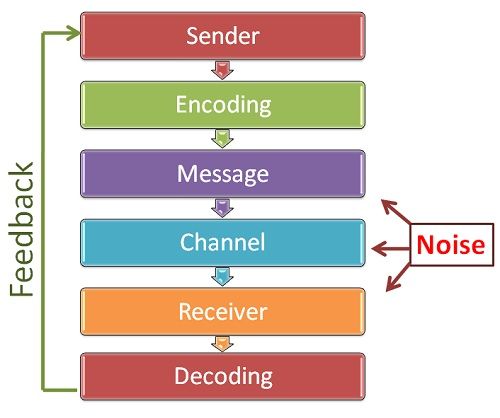Communication Process
Definition: The Communication is a two-way process wherein the message in the form of ideas, thoughts, feelings, opinions is transmitted between two or more persons with the intent of creating a shared understanding.
Simply, an act of conveying intended information and understanding from one person to another is called as communication. The term communication is derived from the Latin word “Communis” which means to share. Effective communication is when the message conveyed by the sender is understood by the receiver in exactly the same way as it was intended.
Communication Process
The communication is a dynamic process that begins with the conceptualizing of ideas by the sender who then transmits the message through a channel to the receiver, who in turn gives the feedback in the form of some message or signal within the given time frame. Thus, there are Seven major elements of communication process:
- Sender: The sender or the communicator is the person who initiates the conversation and has conceptualized the idea that he intends to convey it to others.
- Encoding: The sender begins with the encoding process wherein he uses certain words or non-verbal methods such as symbols, signs, body gestures, etc. to translate the information into a message. The sender’s knowledge, skills, perception, background, competencies, etc. has a great impact on the success of the message.
- Message: Once the encoding is finished, the sender gets the message that he intends to convey. The message can be written, oral, symbolic or non-verbal such as body gestures, silence, sighs, sounds, etc. or any other signal that triggers the response of a receiver.
- Communication Channel: The Sender chooses the medium through which he wants to convey his message to the recipient. It must be selected carefully in order to make the message effective and correctly interpreted by the recipient. The choice of medium depends on the interpersonal relationships between the sender and the receiver and also on the urgency of the message being sent. Oral, virtual, written, sound, gesture, etc. are some of the commonly used communication mediums.
- Receiver: The receiver is the person for whom the message is intended or targeted. He tries to comprehend it in the best possible manner such that the communication objective is attained. The degree to which the receiver decodes the message depends on his knowledge of the subject matter, experience, trust and relationship with the sender.
- Decoding: Here, the receiver interprets the sender’s message and tries to understand it in the best possible manner. An effective communication occurs only if the receiver understands the message in exactly the same way as it was intended by the sender.
- Feedback: The Feedback is the final step of the process that ensures the receiver has received the message and interpreted it correctly as it was intended by the sender. It increases the effectiveness of the communication as it permits the sender to know the efficacy of his message. The response of the receiver can be verbal or non-verbal.
Note: The Noise shows the barriers in communications. There are chances when the message sent by the sender is not received by the recipient.

